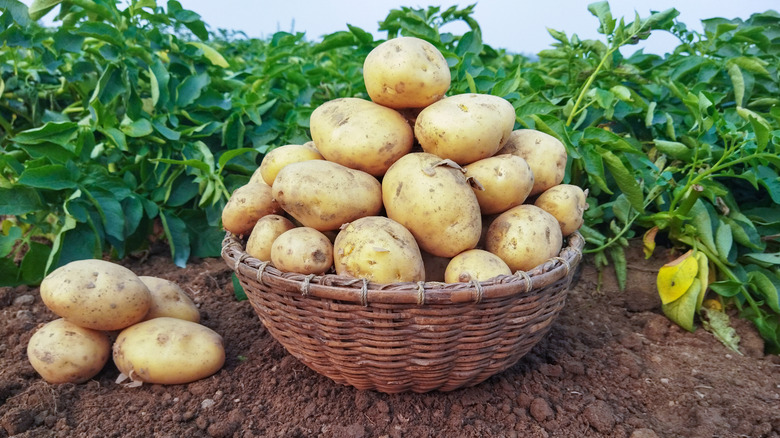Are Potatoes Really An Ingredient In Vodka?
Vodka, an extremely popular alcohol, is considered a versatile spirit and the core ingredient in many mixed drinks for a good reason. It's the lifeblood of the famed Moscow mule (a bubbling with freshly cracked-open ginger beers) and colorful cosmopolitans (yes, we'll take two). America's infatuation with vodka started in the 1950s and was followed by a boom in sales following World War II; according to Saveur, it's only grown since. Martin de Dreuille, Grey Goose's global vice president of marketing, even called it the most popular spirit in the U.S. today — or at least in 2021 — and added that vodka sales accounted for "1/3 of all cocktail sales nationwide," according to Beverage Dynamics.
Clearly, a lot of people love this liquor — but what exactly do they love about it? Well, it's classified as a "neutral spirit" by the Alcohol and Tobacco Tax and Trade Bureau, meaning it has no distinctive character, aroma, taste, or color. People might enjoy this kind of alcohol because it's so easy to mix with others. But what exactly are vodka's own ingredients?
It's a question you shouldn't be afraid to ask, as many people who have been consuming vodka for years don't even know the answer. Some people might say it's potatoes — at least, that's what they've heard. But are potatoes really an ingredient in vodka? Here's a hint: It's probably not what you expect. And you should start paying attention.
Vodka's mysterious origins
Not even the first vodkas had potatoes as an ingredient, so why the association? In order to make sense of it all, you have to dig into the history of vodka itself. The first record of something resembling vodka was in Eastern Europe during the eighth century, according to Thrillist. Back then, it wasn't really seen as a drink — instead, it had other uses, like as a way of cleaning wounds, or as an agent used in gunpowder. Though vodka was traditionally made using wheat, a handful of people began to appreciate vodka more for its high alcohol content, and the brave few that could get past its impurities indulged in it.
According to Thrillist, the vodka-making process was refined after a charcoal filtering method for alcohol was discovered and established by a Russian professor, which helped filtrate impurities. Thanks to this, more and more people over time began to view vodka as the distilled beverage it is today. Along with this progressive development, potatoes were first used to make vodka because it was less expensive than wheat, according to expert Desmond Begg's 1998 book "The Vodka Companion: A Connoisseur's Guide" (via Alcademics).
The process of making vodka varies from place to place and has changed over time. (There's even a debate on whether or not Russia or Poland discovered it first, according to Saveur). But no matter its origins, the question remains: Are potatoes still an ingredient in vodka? According to The Washington Post, for most commercial vodkas the answer is no.
Here's what's probably in your vodka
So, what is it that you're really drinking? Well, vodka is made through a process of fermentation, distillation, and filtration, as Thrillist notes. Every brand of vodka is different, so your vodka could come from technically, literally any fermented material. That being said, the most common materials used are grains like wheat, corn, or potatoes, but fruits such as grapes and even honey are used, too.
So why do people assume potatoes are an ingredient in most vodkas in the first place? Well, potatoes were first used to make vodka only because it was widely available in Russia, according to The Washington Post. But today, they are generally more expensive and labor-intensive to use than grain — at least according to Nicholas Faith's book "Classic Vodka" (via Alcademics).
In short, vodka can be made from almost anything. To figure out what's inside your favorite brand of the spirit, do your research. Whether you select a well-drink or a top-shelf vodka, it's always best to know what you're consuming.


